RENAULT KOLEOS 2012 1.G Owners Manual
Manufacturer: RENAULT, Model Year: 2012, Model line: KOLEOS, Model: RENAULT KOLEOS 2012 1.GPages: 233, PDF Size: 7.81 MB
Page 191 of 233
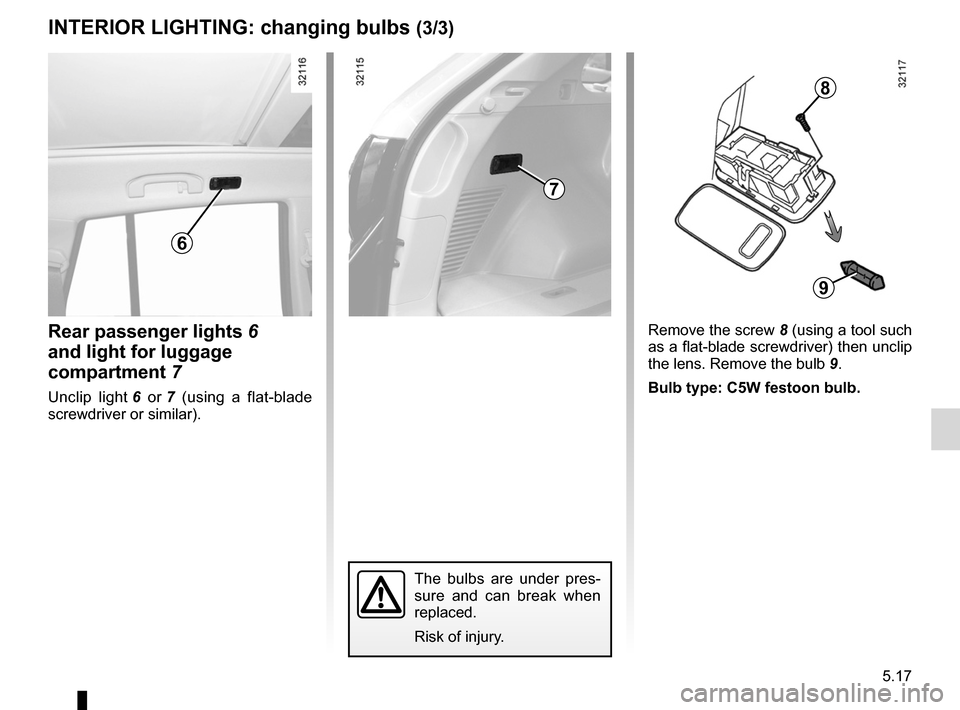
JauneNoirNoir texte
5.17
ENG_UD23660_3
Eclairage intérieur : remplacement des lampes (X45 - H45 - Renault)
ENG_NU_977-2_H45_Ph2_Renault_5
InterIOr lIghtIng: changing bulbs (3/3)
rear passenger lights 6
and light for luggage
compartment 7
Unclip light 6 or 7 (using a flat-blade
screwdriver or similar).
The bulbs are under pres -
sure and can break when
replaced.
Risk of injury.
Remove the screw 8 (using a tool such
as a flat-blade screwdriver) then unclip
the lens. Remove the bulb 9.
Bulb type: c5w festoon bulb.
7
8
9
6
Page 192 of 233
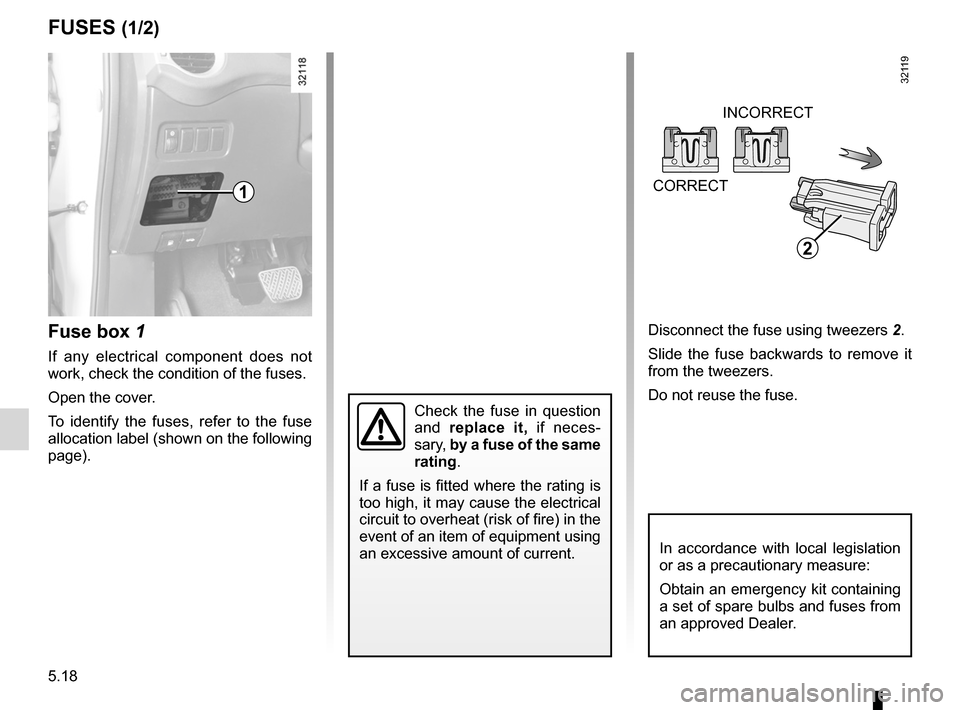
fuses ..................................................... (up to the end of the DU)
5.18
ENG_UD21012_4
Fusibles (X45 - H45 - Renault)
ENG_NU_977-2_H45_Ph2_Renault_5
Jaune NoirNoir texte
Fuses
Fuses (1/2)
32119
Disconnect the fuse using tweezers 2.
Slide the fuse backwards to remove it
from the tweezers.
Do not reuse the fuse.
1
2
CORRECT INCORRECT
Fuse box
1
If any electrical component does not
work, check the condition of the fuses.
Open the cover.
To identify the fuses, refer to the fuse
allocation label (shown on the following
page).
Check the fuse in question
and replace it, if neces-
sary, by a fuse of the same
rating.
If a fuse is fitted where the rating is
too high, it may cause the electrical
circuit to overheat (risk of fire) in the
event of an item of equipment using
an excessive amount of current.
In accordance with local legislation
or as a precautionary measure:
Obtain an emergency kit containing
a set of spare bulbs and fuses from
an approved Dealer.
Page 193 of 233
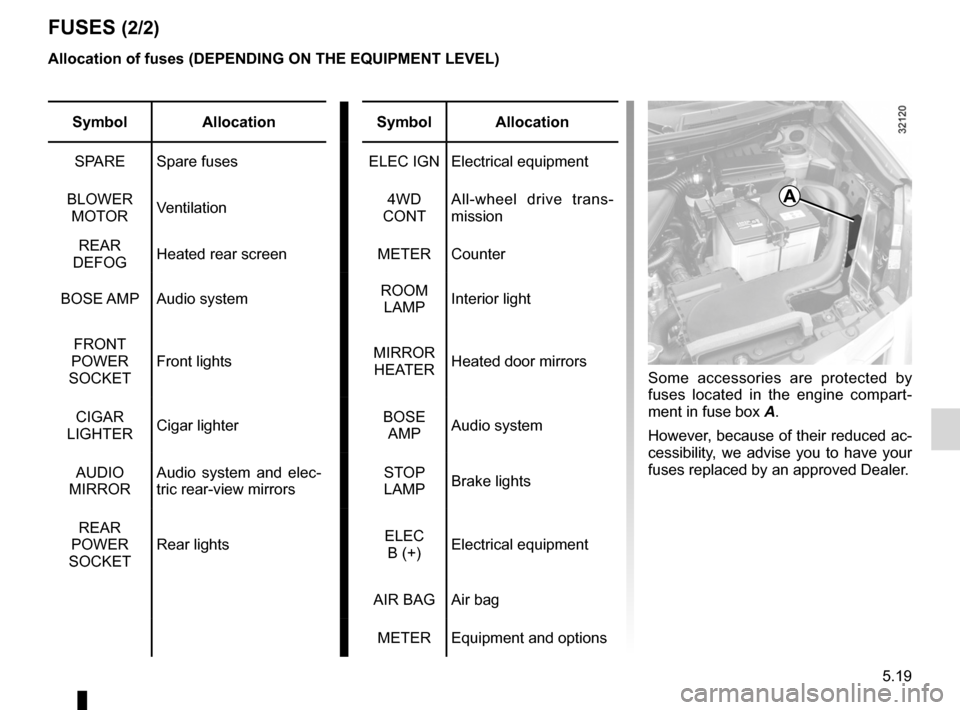
JauneNoirNoir texte
5.19
ENG_UD21012_4
Fusibles (X45 - H45 - Renault)
ENG_NU_977-2_H45_Ph2_Renault_5
Fuses (2/2)
allocation of fuses (DePenDIng On the eQuIPment leVel)
Some accessories are protected by
fuses located in the engine compart -
ment in fuse box A.
However, because of their reduced ac-
cessibility, we advise you to have your
fuses replaced by an approved Dealer.
a
symbol allocation symbolallocation
SPARE Spare fuses ELEC IGNElectrical equipment
BLOWER MOTOR Ventilation 4WD
CONT All-wheel drive trans
-
mission
REAR
DEFOG Heated rear screen
METERCounter
BOSE AMP Audio system ROOM
LAMP Interior light
FRONT
POWER
SOCKET Front lights
MIRROR
HEATER Heated door mirrors
CIGAR
LIGHTER Cigar lighter BOSE
AMP Audio system
AUDIO
MIRROR Audio system and elec
-
tric rear-view mirrors STOP
LAMP Brake lights
REAR
POWER
SOCKET Rear lights
ELEC
B (+) Electrical equipment
AIR BAG Air bag
METER Equipment and options
Page 194 of 233
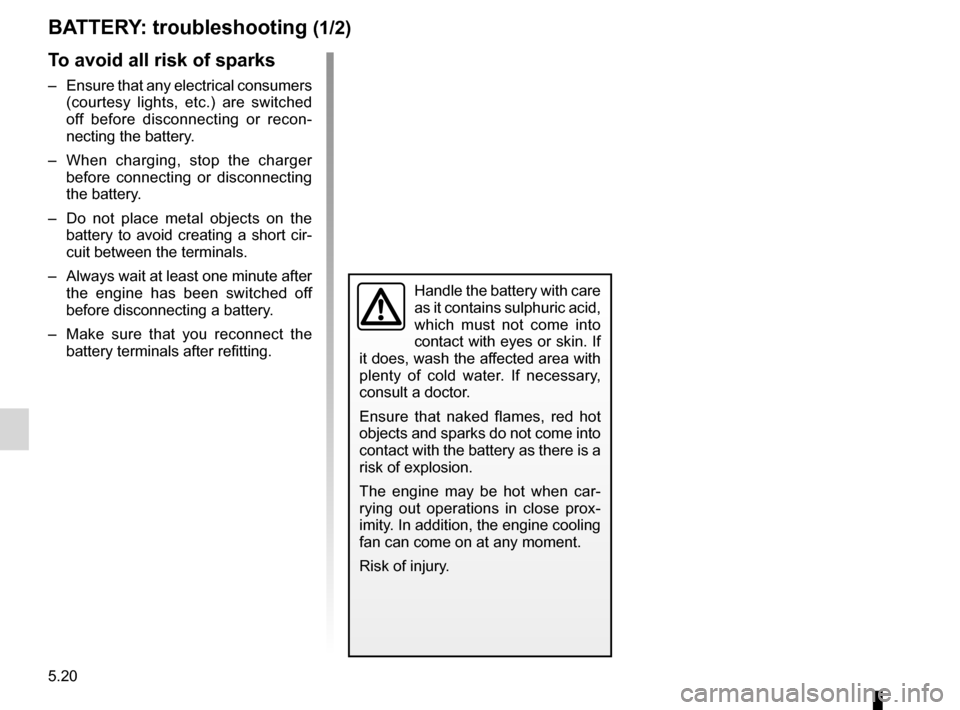
batterytroubleshooting ............................... (up to the end of the DU)
5.20
ENG_UD23536_4
Batterie : dépannage (X45 - H45 - Renault)
ENG_NU_977-2_H45_Ph2_Renault_5
Jaune NoirNoir texte
battery: troubleshooting
Battery: troubleshooting (1/2)
Handle the battery with care
as it contains sulphuric acid,
which must not come into
contact with eyes or skin. If
it does, wash the affected area with
plenty of cold water. If necessary,
consult a doctor.
Ensure that naked flames, red hot
objects and sparks do not come into
contact with the battery as there is a
risk of explosion.
The engine may be hot when car -
rying out operations in close prox -
imity. In addition, the engine cooling
fan can come on at any moment.
Risk of injury.
t o avoid all risk of sparks
– Ensure that any electrical consumers
(courtesy lights, etc.) are switched
off before disconnecting or recon -
necting the battery.
– When charging, stop the charger
before connecting or disconnecting
the battery.
– Do not place metal objects on the
battery to avoid creating a short cir-
cuit between the terminals.
– Always wait at least one minute after
the engine has been switched off
before disconnecting a battery.
– Make sure that you reconnect the
battery terminals after refitting.
Page 195 of 233
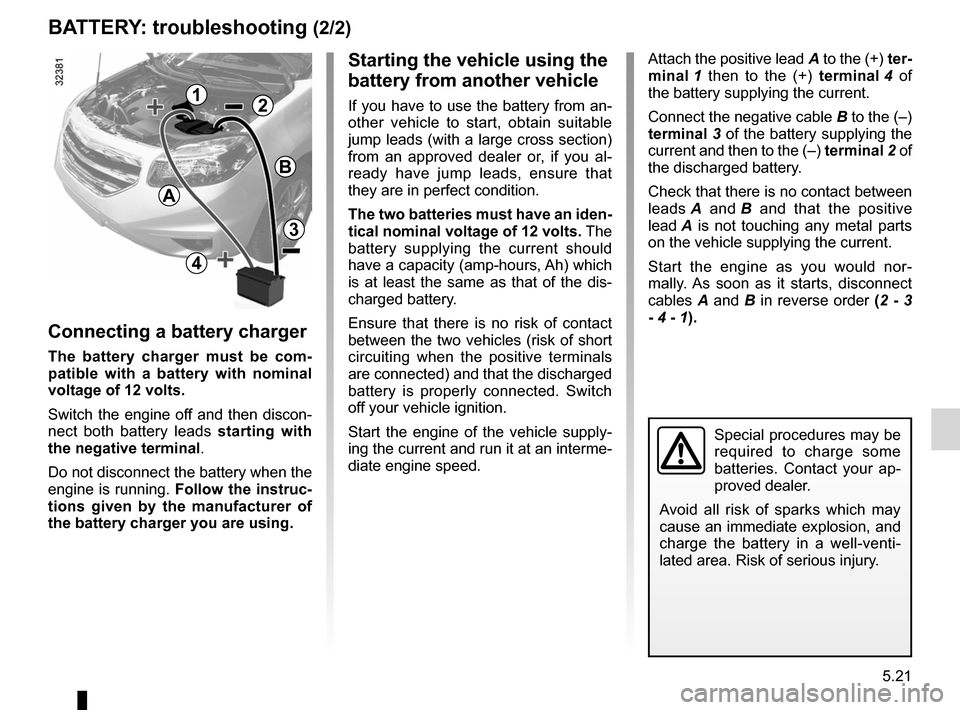
JauneNoirNoir texte
5.21
ENG_UD23536_4
Batterie : dépannage (X45 - H45 - Renault)
ENG_NU_977-2_H45_Ph2_Renault_5
12
B
3
4
a
starting the vehicle using the
battery from another vehicle
If you have to use the battery from an-
other vehicle to start, obtain suitable
jump leads (with a large cross section)
from an approved dealer or, if you al -
ready have jump leads, ensure that
they are in perfect condition.
the two batteries must have an iden-
tical nominal voltage of 12 volts. The
battery supplying the current should
have a capacity (amp-hours, Ah) which
is at least the same as that of the dis-
charged battery.
Ensure that there is no risk of contact
between the two vehicles (risk of short
circuiting when the positive terminals
are connected) and that the discharged
battery is properly connected. Switch
off your vehicle ignition.
Start the engine of the vehicle supply -
ing the current and run it at an interme-
diate engine speed.
Battery: troubleshooting (2/2)
connecting a battery charger
t he battery charger must be com -
patible with a battery with nominal
voltage of 12 volts.
Switch the engine off and then discon-
nect both battery leads starting with
the negative terminal.
Do not disconnect the battery when the
engine is running. Follow the instruc-
tions given by the manufacturer of
the battery charger you are using.
Special procedures may be
required to charge some
batteries. Contact your ap -
proved dealer.
Avoid all risk of sparks which may
cause an immediate explosion, and
charge the battery in a well-venti -
lated area. Risk of serious injury.
Attach the positive lead A to the (+) ter-
minal 1 then to the (+) terminal 4 of
the battery supplying the current.
Connect the negative cable B to the (–)
terminal 3 of the battery supplying the
current and then to the (–) terminal 2 of
the discharged battery.
Check that there is no contact between
leads A and B and that the positive
lead A is not touching any metal parts
on the vehicle supplying the current.
Start the engine as you would nor -
mally. As soon as it starts, disconnect
cables A and B in reverse order (2 - 3
- 4 - 1).
Page 196 of 233
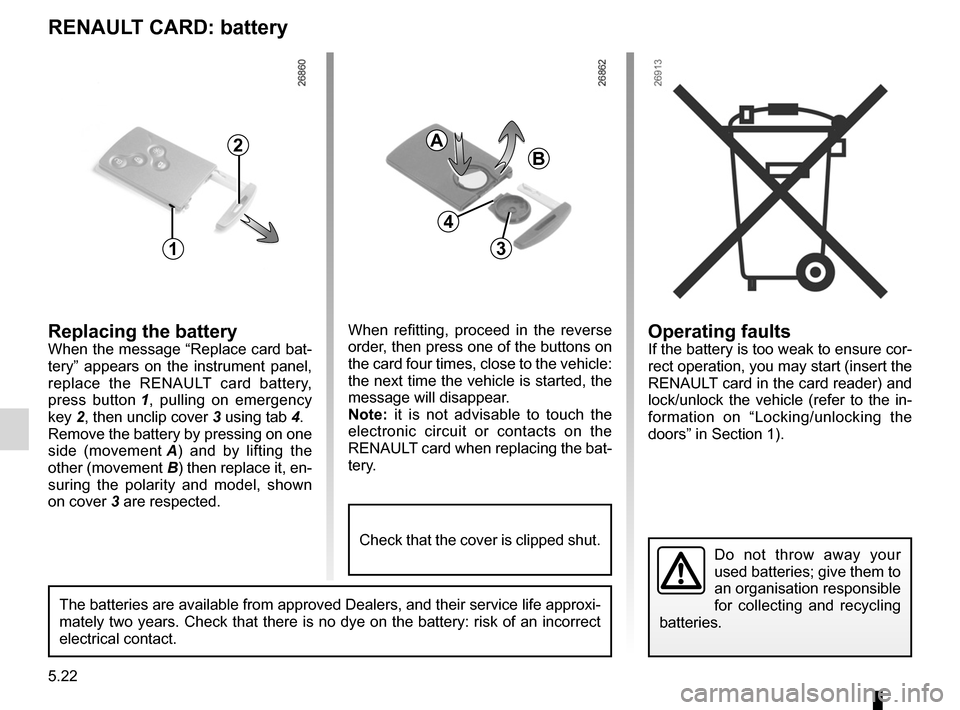
RENAULT cardbattery ............................................. (up to the end of the DU)
RENAULT card battery .........................(up to the end of the DU)
5.22
ENG_UD27283_6
Carte RENAULT : pile (X45 - H45 - X91 - B91 - K91 - X95 - B95 - D95 - E95 - K95 - J95 - R95 - L38 - X38 - X32 - B32 - X98 - Renault)
ENG_NU_977-2_H45_Ph2_Renault_5
Operating faultsIf the battery is too weak to ensure cor-
rect operation, you may start (insert the
RENAULT card in the card reader) and
lock/unlock the vehicle (refer to the in-
formation on “Locking/unlocking the
doors” in Section 1).
RENAULT card: battery
renault carD: battery
replacing the batteryWhen the message “Replace card bat-
tery” appears on the instrument panel,
replace the RENAULT card battery,
press button 1 , pulling on emergency
key 2, then unclip cover 3 using tab 4.
Remove the battery by pressing on one
side (movement A ) and by lifting the
other (movement B) then replace it, en-
suring the polarity and model, shown
on cover 3 are respected.
Do not throw away your
used batteries; give them to
an organisation responsible
for collecting and recycling
batteries.
1
2
When refitting, proceed in the reverse
order, then press one of the buttons on
the card four times, close to the vehicle:
the next time the vehicle is started, the
message will disappear.
n ote: it is not advisable to touch the
electronic circuit or contacts on the
RENAULT card when replacing the bat-
tery.
a
B
3
The batteries are available from approved Dealers, and their service life approxi -
mately two years. Check that there is no dye on the battery: risk of an incorrect
electrical contact.
4
Check that the cover is clipped shut.
Page 197 of 233
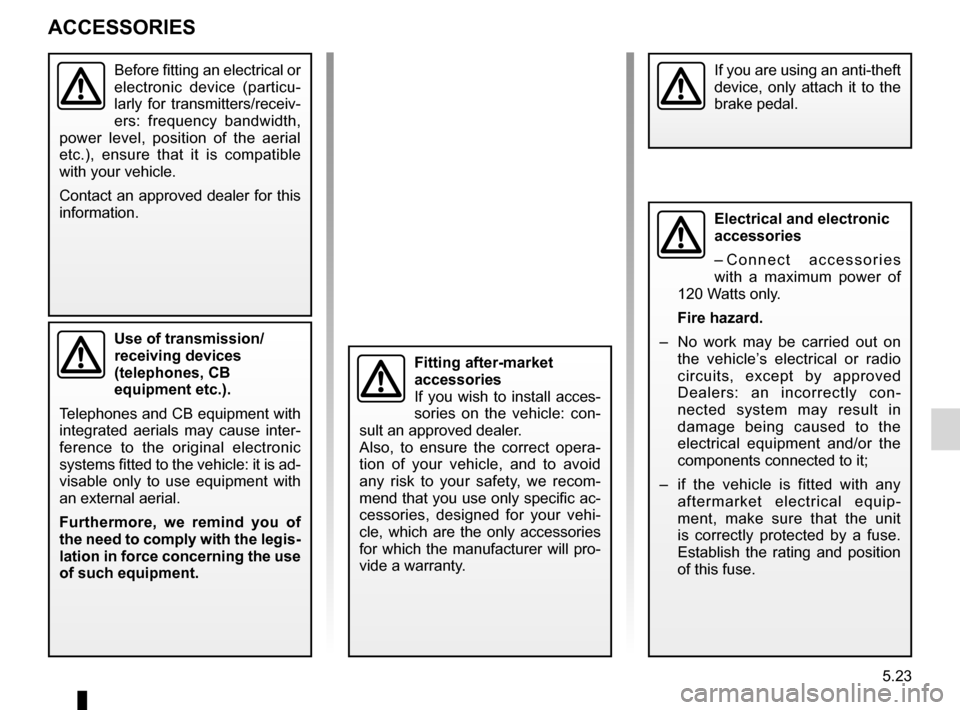
accessories...........................................(up to the end of the DU)
5.23
ENG_UD21015_4
Accessoires (X35 - X45 - H45 - S65 - X77 - X81 - J81 - X84 - B84 - C84 - E84 - L84 - K84 - J84 - X85 - B85 - C85 - S85 - X91 - B91 - K91 - D91 - X76 - X83 - X61 - F61 -
ENG_NU_977-2_H45_Ph2_Renault_5
Accessories
accessOrIes
use of transmission/
receiving devices
(telephones, cB
equipment etc.).
Telephones and CB equipment with
integrated aerials may cause inter -
ference to the original electronic
systems fitted to the vehicle: it is ad-
visable only to use equipment with
an external aerial.
Furthermore, we remind you of
the need to comply with the legis-
lation in force concerning the use
of such equipment.
electrical and electronic
accessories
– C o n n e c t a c c e s s o r i e s
with a maximum power of
120 Watts only.
Fire hazard.
– No work may be carried out on
the vehicle’s electrical or radio
circuits, except by approved
Dealers: an incorrectly con -
nected system may result in
damage being caused to the
electrical equipment and/or the
components connected to it;
– if the vehicle is fitted with any
aftermarket electrical equip -
ment, make sure that the unit
is correctly protected by a fuse.
Establish the rating and position
of this fuse.
Before fitting an electrical or
electronic device (particu -
larly for transmitters/receiv-
ers: frequency bandwidth,
power level, position of the aerial
etc.), ensure that it is compatible
with your vehicle.
Contact an approved dealer for this
information.
Fitting after-market
accessories
If you wish to install acces-
sories on the vehicle: con -
sult an approved dealer.
Also, to ensure the correct opera -
tion of your vehicle, and to avoid
any risk to your safety, we recom -
mend that you use only specific ac-
cessories, designed for your vehi -
cle, which are the only accessories
for which the manufacturer will pro-
vide a warranty.
If you are using an anti-theft
device, only attach it to the
brake pedal.
Page 198 of 233
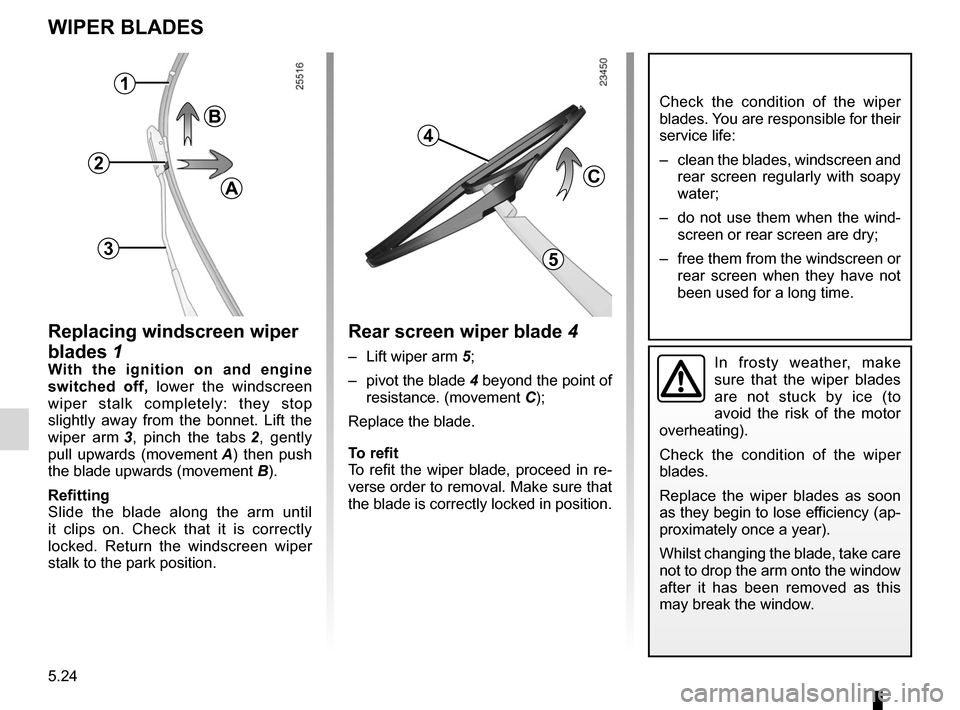
wiper blades ......................................... (up to the end of the DU)
wipers blades ............................................. (up to the end of the DU)
5.24
ENG_UD20957_3
Balais d’essuie-vitre avant (X45 - H45 - Renault)
ENG_NU_977-2_H45_Ph2_Renault_5
Wipers (replacing blades)
wIPer BlaDes
Check the condition of the wiper
blades. You are responsible for their
service life:
– clean the blades, windscreen and
rear screen regularly with soapy
water;
– do not use them when the wind-
screen or rear screen are dry;
– free them from the windscreen or
rear screen when they have not
been used for a long time.
In frosty weather, make
sure that the wiper blades
are not stuck by ice (to
avoid the risk of the motor
overheating).
Check the condition of the wiper
blades.
Replace the wiper blades as soon
as they begin to lose efficiency (ap-
proximately once a year).
Whilst changing the blade, take care
not to drop the arm onto the window
after it has been removed as this
may break the window.
replacing windscreen wiper
blades 1
w ith the ignition on and engine
switched off, lower the windscreen
wiper stalk completely: they stop
slightly away from the bonnet. Lift the
wiper arm 3 , pinch the tabs 2 , gently
pull upwards (movement A ) then push
the blade upwards (movement B).
refitting
Slide the blade along the arm until
it clips on. Check that it is correctly
locked. Return the windscreen wiper
stalk to the park position.
1
2
3
a
rear screen wiper blade 4
– Lift wiper arm 5;
– pivot the blade 4 beyond the point of
resistance. (movement C);
Replace the blade.
t o refit
To refit the wiper blade, proceed in re-
verse order to removal. Make sure that
the blade is correctly locked in position.
4
c
5
B
Page 199 of 233
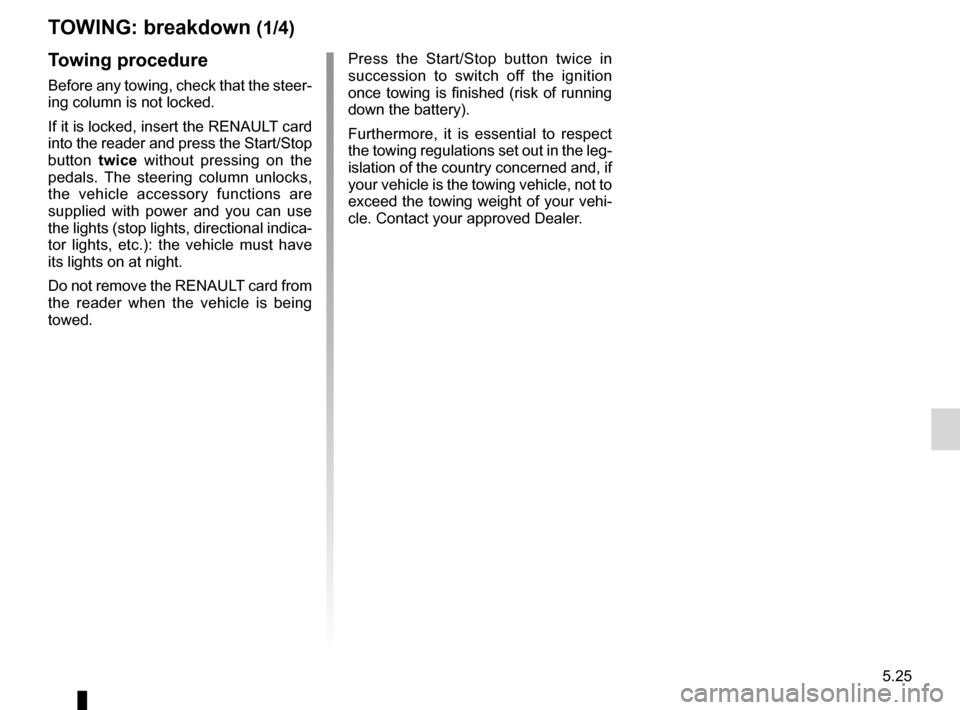
towingbreakdown ...................................... (up to the end of the DU)
towing hitch ........................................... (up to the end of the DU)
5.25
ENG_UD23537_3
Remorquage : dépannage (X45 - H45 - Renault)
ENG_NU_977-2_H45_Ph2_Renault_5
Towing
tOwIng : breakdown (1/4)
t owing procedure
Before any towing, check that the steer-
ing column is not locked.
If it is locked, insert the RENAULT card
into the reader and press the Start/Stop
button twice without pressing on the
pedals. The steering column unlocks,
the vehicle accessory functions are
supplied with power and you can use
the lights (stop lights, directional indica -
tor lights, etc.): the vehicle must have
its lights on at night.
Do not remove the RENAULT card from
the reader when the vehicle is being
towed.
Press the Start/Stop button twice in
succession to switch off the ignition
once towing is finished (risk of running
down the battery).
Furthermore, it is essential to respect
the towing regulations set out in the leg-
islation of the country concerned and, if
your vehicle is the towing vehicle, not to
exceed the towing weight of your vehi-
cle. Contact your approved Dealer.
Page 200 of 233

5.26
ENG_UD23537_3
Remorquage : dépannage (X45 - H45 - Renault)
ENG_NU_977-2_H45_Ph2_Renault_5
Jaune NoirNoir texte
tOwIng : breakdown (2/4)
3233032331
2wD vehicles
Vehicles fitted with an automatic
transmission or continuously vari -
able transmission.
w ith the ignition off, the gearbox is no
longer lubricated. If it is not, the vehi -
cle must be transported on a trailer or
be towed with the front wheels off the
ground.If the lever is stuck in P,
even though you are de -
pressing the brake pedal,
the lever can be released
manually.
To do this, first remove the cover 2
on the left-hand side of the gear
lever.
While depressing the brake pedal,
shift the gear lever into neutral ( n )
and simultaneously press the
button 1 on the lever and on the
button under the cover 2.
2
1